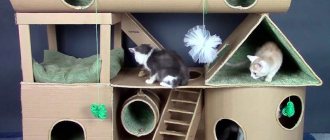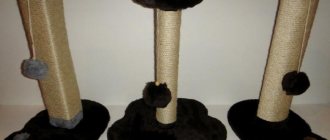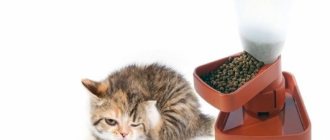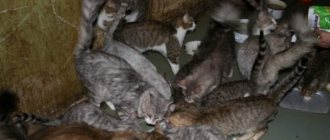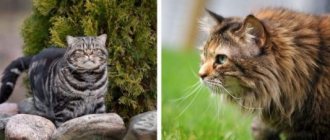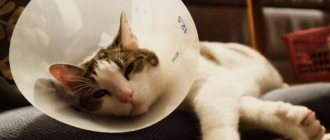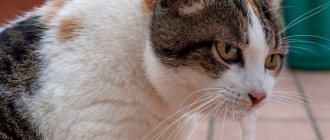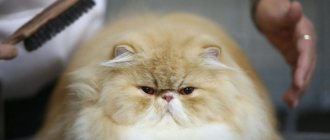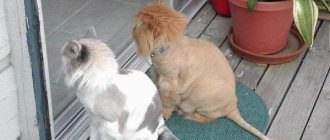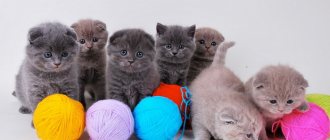- home
- Cats
- Making a toy for a cat with your own hands
A great way to entertain your pet is with a DIY cat toy. You can make it from almost anything that is currently at hand. This will not only be an active game for a small pet, but also a developmental activity, because you need to train in agility and speed at any time of the day and at every age. The easiest way to make a mouse is for a cat, but there are many more options available.
A great way to entertain your pet is with a DIY cat toy.
How to choose a toy for a cat
In order for the toy to truly interest your pet, you should pay attention to important points:
- the material from which the toy is made must be ergonomic and not have a strong odor;
- You should not use a toy of poisonous colors, as this may scare away the animal;
- there is no need to purchase toys that are too small, as your pet may swallow or choke on a small object;
- You should not give your cat a heavy toy, otherwise it will be difficult for the pet to move it;
- It is not recommended to give your pet an overly hard toy, so that he does not hit the sharp corners of the product or break his teeth on a hard surface;
- The toy can be easily washed.
When choosing a toy, you should pay attention to the pet’s individual character traits, health status and age restrictions. For example, if a cat gains a lot of weight after sterilization, give preference to those toys that stimulate the animal to move.
For a cat with poor eyesight, toys with sound accompaniment are suitable. The best option is to offer your pet several toys and from this draw a conclusion about the preferences of your furry friend.
What sense organs should toys act on in order to attract the animal’s attention:
- vision - glowing, moving, shaking toys (balls, laser pointer, sunbeams, running mice and various interactive structures);
- hearing - bells, imitation of bird voices, rustling, ringing, grinding;
- touch - fur or lint, similar to the skin of an animal;
- taste and smell - specifically smelling material, adding favorite aromas to the toy (fish, poultry, meat, catnip, honeysuckle, etc.).
Built into furniture
Universal pieces of furniture that include sitting areas for the cat. This could well be a closet with three compartments, two of which contain the owners’ personal belongings, and the third section is equipped as a resting place for a mustachioed friend. A good idea on how to make a house for a cat is bookshelves, where scratchers love to sleep.
Such models can hardly be found in pet stores, but loving owners will always come up with something to make a house for a cat from. They are ready to allocate a free part of the furniture for the rest of their furry friend.
Homemade cat toy from a box
The indisputable fact that purrs adore all kinds of boxes can and even should be used when it comes to crafts for our little brothers. There are many options for crafts from them, but the most interesting are sorters and houses.
Sorter track made from a box and toilet paper rolls.
These, at first glance, absolutely unnecessary items will actually be an excellent nursery rhyme for a kitten.
To make it you will need:
- Cardboard shoe box.
- Toilet paper rolls - the number depends on the size of the box.
- Glue.
These, at first glance, absolutely unnecessary items will actually be an excellent nursery rhyme for a kitten
You need to carefully place the bushings inside the box, smearing them with glue along the bottom circle so that they stick to the bottom and along the outside to glue them together. Decorate the resulting sorter with pompoms, hanging ribbons, yarn fringes, small soft animal figures, and decorate it with bright colors.
There are never too many holes - the simplest game with a box
For this craft you will need a relatively thin box, for example from pizza, paintings and similar goods. The main thing is that the sides are of small height.
We take the workpiece and cut identical round holes in a random order of such a size that the pet’s paw fits freely in it. Close tightly and give to your pet.
For this craft you will need a relatively thin box, for example from pizza, paintings and similar goods
To make the sorter boxes less mobile, it is enough to glue rubber clamps to their bottom. Then the cat will not slide on the floor while playing.
Boxed paradise for purrs
You shouldn’t bother buying an expensive house for your cat at a pet store, because you can make it yourself, all from the same cardboard boxes of different sizes.
To create a cat house you need:
- Several boxes made of durable cardboard. They can be the same or different in size, but the pet should be able to easily climb into the smallest one and not get stuck there.
- Glue, preferably construction glue, acrylic, is odorless and colorless.
- Decorations are optional, without them it will also be nice.
Don't bother buying an expensive house for your cat at a pet store.
The first step is to group the “rooms”, building the future home of the fluffy at your discretion. With a pencil or pen, mark the position of all the holes for the animal's entry and exit so that it can climb through the rooms without going out every time. Then glue them together one by one, generously lubricating them with glue so that they hold tightly. For greater aesthetics, cover the outside of the house with a thin layer of paint (gouache, watercolor) or simply draw cute drawings with pencils or felt-tip pens.
And if you hang small trinkets in every room, then the purr’s delight will know no bounds for a long time.
Mouse is a number one hit
There is no need to even mention how popular this couple is - a cat and a mouse, so such a toy is an almost obligatory accessory. If the housewife knows how and loves to knit, then a rodent can be knitted, but products made from thick textiles are no less attractive to kittens and cats. The range of candidates for the role of a mouse is large. This:
- drape;
- suede (artificial);
- fur;
- felt;
- fleece
In addition to the fabric, you need to prepare:
- sewing supplies;
- holofiber, cotton wool or foam rubber; their replacement is leftover yarn.
The operation will not take much effort or much time.
- First, a triangle is cut out from the selected material, then its two sides are sewn together.
- One or more fillers are tightly stuffed into the resulting bag. The edge is basted, then the seam is pulled together and the thread is tied.
- Ears and a tail are cut out of the fabric, and these elements are sewn on very securely.
It is better to draw the eyes of the mouse, since the sewn beads will become a big threat to the baby. They can be replaced with small buttons, but only if it will be very difficult for the “naturalist” to get to the threads holding them in place.
A soft toy can be more than just a mouse, although ears and a tail make for an exciting journey through the rooms with the prey. With the same success they sew fish, birds, tigers or piglets. Small balls sewn together and yarn are used to make insects with legs, such as caterpillars.
Master class No. 3
If you often find yourself in the mood to play with your pet in person, then you cannot do without a shiny cat toy on a stick. Why not use your imagination here too and use a real, beautiful and intricate toy instead of an old candy wrapper on a string? You will need:
- felt;
- embroidery threads;
- cat mint;
- padding material;
- wooden or metal stick;
- various shiny little things for decoration (sequins, pompoms, etc. that come to hand);
We will need diamond-shaped parts. To make them, first draw two small equilateral triangles on paper - the length of each side should be approximately 6-7 cm. Draw them so that they have one common side - you get a rhombus. Cut out a shape from paper and use it as a pattern. For one toy you need two of these parts. Fold the resulting diamonds into a pyramid, as shown in the figure.
Starting from the tip, start stitching the parts. As you move along each side, your toy will become voluminous. When you are almost done sewing it up, leave a small hole and stuff it with the prepared padding material. Add some catnip inside. After this, continue sewing the toy. It is recommended to run the thread and needle along the borders again to make sure it is securely sewn. Do not rush to cut the thread - make it long so that it is comfortable to hold it.
After this, you can start decorating the stick. The stick is not mandatory, but if you want to make the toy more interesting, then attach the free end of the thread to the stick - you need to wrap the thread around the end of the stick several times, tie it in a knot, and then glue a small piece of felt around it - for beauty and strength. Then attach to a thread, tying knots, everything you have prepared to attract your cat’s attention - shiny candy wrappers, pieces of bright fabric, rustling pieces of paper, and the like. The toy is ready!
A little about the herb catnip (catnip)
Why do most cats love catnip grass so much? Veterinarians say that catnip is a cat's cure for stress. Now many products are produced for cats using this plant: various sticks, balls, toys. There are even drops that are used to drip onto the scratching post - this is how the cat gets used to sharpening its claws and not damaging the furniture.
If the cat has no appetite, catnip is recommended as a food supplement. Add a pinch of dried or fresh herbs. Catnip is also an anthelmintic. Catnip is sold at any pet store; you can plant it at home in a pot. At the same time, you need to make sure that the cat does not eat it all at once, and there is no doubt that he will like it.
On video: why cats love catnip.
Toy out of the box for intelligence development
Interactive toys and labyrinths are very popular among cat owners, which not only captivate their pets, but also help develop their intelligence. Such devices are not cheap, so many people create them with their own hands.
Your pet will definitely love this homemade puzzle made from a cardboard box. Several holes are made in the body from different sides. Holes of equal size are also cut out on the lid of the box. They should not be too large so that only the pet’s paws fit through them.
To prevent the box from quickly losing its shape, it is taped around the entire perimeter. Place any round objects inside that easily roll when the cat touches them with his paw.
Another popular educational toy idea is a tunnel house. It is also made from a box, but larger in size. The pet should freely enter the tunnel through the holes on the sides. To attract the cat's attention, colorful ribbons are attached to the box, and fragrant treats, balls, and rustling toys are placed in the house.
Miniature rattle
The next cat toy idea is to create a rattle.
The sound-making beads inside will attract the pussy's attention.
The cat will chase her like prey and try to catch her.
To create a toy you will need:
- medicine bottle;
- beads or other elements that will rattle inside;
- cover and/or tape.
Wash the empty jar; if there is a label, remove it.
Then place the beads inside.
Alternatively, you can use any small items such as seeds or bells.
The toy must be tightly closed so that the cat cannot reach the contents.
If the lid is not tight enough, you can wrap the neck with regular tape.
Scented toy is not for everyone
Making such a tasty-smelling toy is a good chance to arouse the kitten’s interest in a new item. In this case, it is enough to have at home:
- sewing supplies;
- small pieces of relatively dense fabric (linen, cotton);
- polyethylene, “able” to rustle;
- dried catnip (catnip);
- decorative elements - ribbons, pompoms, cords.
First, make a drawing of the future bag (square, rectangle, oval).
- The pattern is transferred to the fabric, then a sachet is cut out from it, leaving seam allowances: 2 parts are cut out, they must be absolutely identical.
- The blanks are placed face to face, stitched manually or on a sewing machine, and a small hole is left.
- After turning the product inside out, pieces of polyethylene and catnip are placed in it, and the hole is sewn up.
- Decorate the toy at your discretion - with pompoms, ribbons or laces.
An easier way is to use finished products left without a pair as a bag - children's mittens or socks. In this case, you only need to tighten the open edge with a strong thread and tie it in a knot. The easiest option without sewing is a knot with grass; in this case, no manipulations other than tying are required at all.
It should be noted that there are some “wrong” creatures in the world from the family of feline predators. They don't react to this plant at all. If the owners “caught” such a kitten, then there is a high probability of completely ignoring this fragrant toy.
Heart mouse for a cat
This is an anti-stress toy option, intended only for animals. You can fill the heart with various grains (barley, oats, buckwheat) and dried herbs. Catnip, chamomile, and wheatgrass are good options. But under no circumstances should you take plants such as dope, henbane, wormwood, and hogweed to fill the pad. These herbs are poisonous and dangerous to your pet's health.
To work you will need:
- multi-colored pieces of fabric;
- filler;
- sample;
- pins;
- lace;
- scissors, thread, needle.
Master class on making a heart:
- Hand draw or print a heart template. Place two matching pieces of fabric together, trace and cut along the outline. To prevent the pieces of fabric and the pattern from shifting, they need to be attached to each other with tailor's pins.
- Place the two pieces right sides together. Place a small piece of lace between the parts - this is the future tail of the mouse. It should be exactly in the middle and stick out about a centimeter. Sew the pieces together, leaving a small hole at the blunt end of the pad.
- Turn the heart right side out.
- Fill the pad with filler and carefully sew up the hole left earlier.
- Using a needle, thread a piece of lace through the blunt end of the heart and tie knots at the free ends. This will symbolize the mouse's mustache. Sew two eyes cut from dark pieces of fabric a little higher.
Play complexes made from scrap materials
Some owners create complex play complexes for their pets with their own hands. For such structures, cardboard, plywood, plastic pipes, and hoses are used, which can be purchased at the plumbing department. Any man can bring such a project to life. It will require the following materials:
- plastic corners – 4 pcs.;
- pieces of plastic pipes (diameter 110 mm) – 4 pcs.;
- ping pong balls.
The sections must be connected using corners into a closed square, 8 holes with a radius of about 40 mm must be cut in the pipes so that the cat can freely enter the maze. The balls need to be placed in the pipes. The cat will try to get into the pipe to get them.
Pompom - a light toy for kittens
Pom-poms are classic cat toys.
Pompoms on a string are the favorite toy of many cats, which they do not get tired of for a long time. Ready-made toys can be hung on the doorknob so that the cat tries to get them.
Pompoms on the door are very attractive to cats.
Another option for a soft toy for a kitten or adult cat is a pompom.
It’s even easier to make than a mouse or a fish.
- Gather fabric strips of equal length.
- Fold the resulting bundle in half and tie it tightly in the center.
- Cut strips on the fold.
- Distribute the ponytails evenly.
This completes the pompom for the cat.
All that remains is to cut at the fold
Construction materials
The following materials are most often used to build a cat’s home:
- for the manufacture of the frame, chipboard, MDF and plywood sheets, boards made of natural wood are suitable;
- it is possible to sew a soft house for your beloved cat in the form of a comfortable bed from fabric and foam filling;
- simply create cat houses from ordinary boxes;
- To decorate a scratching post for a furry one, you should stock up on jute or sisal rope. Just do not need to secure them with staples or nails, since the animal can damage its limbs;
- PVC pipes or metal and wood products are suitable for the base of the scratching post;
- synthetic winterizer and foam pieces are chosen as filler for pillows and mattresses;
- the interior is decorated with fur, plush or fleece;
- to cover the external facade, the material is selected based on the animal’s habit of tearing its claws: carpet would be a good option;
- adhesive compositions for work should be purchased without a pungent odor, which can scare away the cat.
How to make a cat house quickly and inexpensively
I would like everyone’s favorite to have a house, but sometimes I don’t have enough time or money. You can make a cat's home from scrap materials without spending a lot of time. Here is one idea for such a light house.
- Cardboard or wooden box
- Old T-shirt
- Stapler
Making a house
- Prepare the box: glue the cardboard in the torn places, clean the wooden box from unnecessary parts, such as nails, staples and other objects that can harm the animal.
- The box should only be open on one side. Place a T-shirt over the box so that the neckline is in the middle of the open side of the box. This will be a kind of entrance to the house.
- Carefully fold the excess material from the hem of the T-shirt to the bottom of the box and secure everything with a stapler so that the material does not dangle. Tuck the sleeves inside.
- You can first put a soft mattress for the animal or a rug inside the box.
There you have it, an easy version of a cat house!
You can always pay attention to your beloved pet and give the cat his own house, even if you don’t have enough time. Cats love to climb into various containers and cabinets.
So why not give them their own place where they can hide and play? This will bring the animal a lot of joy and pleasure.
Cat fishing rod
DIY cat fishing rod.
A thin wooden stick, strong thread and strips of thin fabric are all you need to make a cat fishing rod. Fold the fabric overlapping and use a needle to thread the thread through the strips. Tie the free end of the thread around the stick.
When the issue of entertaining cats is resolved, a lot of free time is freed up. Why not spend it on improving the interior of your home? For example, check out 15 tricks that will turn a nursery into a child’s dream room.
Basic requirements for toys for pets.
Regardless of whether a purchased or homemade trinket is used for the tailed amusement, it must meet the following requirements:
- Safety. The materials used for it must be environmentally friendly, with high-quality dyes, fillers, without sharp corners, protruding threads and other imperfections.
- Strength. Having sharp teeth and claws, kittens can easily tear a cheap store-bought treat, feast on its contents or parts, causing health problems.
- Focus on the development of natural instincts. The best cat toys encourage them to hunt, jump, run, lurk, attack, and more.
All this can easily be realized in simple crafts from waste materials. To choose what kind of toy you want to make for your pet, take a look at the gallery and look at examples of finished works.
What's the use of it
There really are a lot of advantages to such an unusual toy. We'll deal with everyone. To put it very simply, a food puzzle is a food dispenser, that’s all. But…
Your pet will eat more slowly - and this is the key to his health and the foundation of longevity. And at the same time move a lot and invent ways to obtain food “hunting”.
By the way, zoologists agree that this type of nutrition is more correct than with free access to dry food.
- If your pet has problems with excess weight, this useful device will help reduce the amount of food eaten and ensure the burning of excess weight through greater physical activity.
- May help animals prone to vomiting from haste while eating. This toy feeder encourages leisurely eating of food or treats.
- It forces you not only to exert physical effort, but also trains your cat’s intelligence. A homemade food puzzle for a cat will make it more active, dexterous, and smarter.
The principle of operation is this: the cat needs to think and act on the toy in a certain way in order to get the treasured treat. Food puzzles perfectly develop logical thinking and the “hunter” instinct.
In the wild, it is unlikely that you will come across a bowl filled with mice. And with such a toy, a whole world of adventure is open to the cat.
Physical activity increases and a new hobby appears that will protect your curtains and sofa from an overly active animal. In addition, this is a great activity for those times when our cat is left to his own devices. For example, when it’s night outside or the owners leave and leave the animal alone.
Pipe
So, what kind of design is this? This cat toy is a type of educational toy; it is a closed tube with holes the size of tennis balls. There are several of the same balls inside. The cat enjoys playing with them, rolling them around and trying to catch them out of the pipe.
Making a toy
You need four plastic sewer pipes, more precisely, pipe corners with a diameter of about 20 cm, as well as a flexible plastic tube (cambric type) to secure the cut holes and improve them.
Wrap two or three turns of electrical tape around the narrower edge of the pipe. Cut two holes in each corner. We connect the pipes, tightly fitting each other into a single structure.
On the cambric we make a cut lengthwise and tighten each hole, we get holes that are safe for the cat, into which you can climb with your paw and play.
You can also put crumpled paper candy wrappers into the toy; tailed pets play with them with pleasure. True, you will have to collect garbage around the apartment more often. Such a toy for a cat can be bought ready-made in a store, but its cost will be more than 10 times more expensive than one made by yourself.
Homemade cat toy. Cheap and easy homemade cat toy
Interactive cardboard and plastic games
A four-legged child can also be interested in other educational crafts. Such structures are made of wood, cardboard or plastic. In the latter case, plumbing pipes or elbows are used.
Plastic ring
To assemble an unusual toy for a kitten, you need to get and prepare:
- plumbing plastic elbows - 4 pieces;
- flexible plastic tube (diameter - 5 mm) for edging the holes;
- drill with attachment;
- electrical tape;
- glue;
- sharp knife, file, sandpaper;
- small tennis ping pong balls and/or treats.
The step-by-step creation of an interactive design looks like this:
- A ring is assembled from plumbing blanks: they first wrap electrical tape around their edges, then smear them with glue and connect them. Wait for it to dry completely.
- In the upper part, along the entire perimeter of the product, holes are drilled of such a diameter that the ball and, naturally, the paw of a kitten and an adult creature do not fit into it too freely, since the structure is made for growth.
- Their edges are processed with a knife or file, then with sandpaper. A thin tube is cut lengthwise, then glued along the perimeter of the holes and allowed to dry. Balls are placed in the finished ring and treats are poured in.
Having made such a simple design, the owners have the right to hope that for some time the stomping of a small animal and the noise from its toys will not be heard in the apartment, because everything new and unknown is always very attractive. Especially for creatures whose curiosity can be the subject of legends.
Cardboard house
This material is very popular, if we talk about “handmade” in general. Cardboard is available, can be found in almost any household, and it is quite easy to make various useful items from it. Even a simple open cat box automatically becomes a magnet—enough reason to explore. However, such a basic cardboard option will interest the kitten only for a short time. Therefore, it is better to choose other designs.
- A labyrinth of several boxes. It is much more attractive even for adult animals. In this case, as many boxes are glued together as the room can allow. Door (window) openings are cut out between them, box lids are removed so that you can quickly get out of the maze, or they are left in place, making life difficult for the pet.
- Large shoe box. This is also a simulator that, like a plumbing plastic ring, teaches intelligence. Round holes are cut out on all surfaces of this object into which you can insert your paw and then pull it out without difficulty. The lid is attached to the box with tape, and a small mouse, balls and favorite treats are placed inside.
Another convenient product that can serve as such an interactive toy is a food container. In this case, the hunter-kitten will see his “victims,” and this contact will become an incentive to quickly solve a difficult problem.
Cardboard sleeve platform
Such material for interactive toys can be found in every home, and besides, it is easy to accumulate. In this case, the main characters will be cardboard tubes from various rolls: toilet paper, paper towels, baking parchment or foil.
They are glued horizontally and vertically to a sheet of thick cardboard. Holes are made in the lying elements, and treats are simply poured into the second, standing elements, or small toys are hidden. By creating such a playground, we can hope that the restless kitten will find something to do for a long time.
Corrugated cardboard - raw material for toys
This method of creating crafts for kittens is also quite simple. Several identical circles are cut out of cardboard, and holes are then made in the center with an awl. The blanks are strung on a cord, and its ends are tied in knots. Using this technique, you can make various figures: for example, the popular and beloved mouse by kittens.
Almost every owner who carefully studies the habits and preferences of his inquisitive pet will be able to come up with his own signature version on the theme “Homemade toys for kittens.” Knowing all the “weaknesses” of a furry pet, it is easier to make a toy that he will not abandon after a short period of time.
It is customary to share ideas with others, which many “inventors” do with pleasure. You can get to know some of the recipes closely by watching the following fascinating video:
Cardboard houses are allowed, cardboard toys and threads are not.
Kittens, like children, try everything, so it makes sense to exclude small cardboard toys and various kinds of thread pompoms until they are one year old. Kittens can choke on string or small pieces of cardboard. But no cat will remain indifferent to large cardboard boxes. Especially if it is corrugated cardboard from which the house is made. They won’t chew, but they will happily hide and scratch.
The technology is the simplest - using a cutter using a thread secured in the center, we successively cut out several circles and rings. The circles are the roof, we cut the rings, and, pushing them apart (so that the overlap appears as in the photo), we assemble the hut. It is better to secure the structure with a strong thread and a thick needle; you should not use staplers.
It’s even easier to take some fabric (preferably brightly colored flannel), three slats (you can use the long handle of a broken plastic mop or something similar). Depending on the piece of fabric, cut it into triangles or sew slats into a single piece. There is no need to make a floor; just a bedding is enough, which will be easier to clean. We connect the slats in the upper part, decorating to taste, and the elegant home for the cat is ready.
How to make one-story cat houses from boxes
What do you need
- 2 identical large boxes;
- adhesive tape;
- scissors;
- stationery knife;
- marker, pencil or pen;
- brush or roller;
- White paint;
- yellow paint;
- pink paper;
- glue gun;
- paper with drawings and patterns;
- twine;
- 2 colored straws for drinks;
- litter
How to do
1. Take the first box and seal the seam at the bottom with duct tape on the outside and inside.
YouTube channel Cuteness
2. On the reverse side, cut off the two side flaps.
YouTube channel Cuteness
3. Adjust the other two sashes with scissors to form triangles.
YouTube channel Cuteness
4. Draw the outline of the door in front under one triangle - a large vertical rectangle, divided in half lengthwise. Cut the cardboard along the marked lines and along the base of the box. Open the resulting door.
YouTube channel Cuteness
5. On the side of the box, draw a window with a frame and cut along the contour.
YouTube channel Cuteness
6. On the triangle above the door, draw and cut out a small round window with a frame.
YouTube channel Cuteness
7. Take the second box and separate the two side walls from it. Glue them together.
YouTube channel Cuteness
8. Place the structure on the house and attach it to the back and front to the triangles.
YouTube channel Cuteness
9. Paint the walls of the house white. Paint the doors outside and inside with yellow paint.
YouTube channel Cuteness
10. Cut out “tiles” from pink paper - many not too large rectangles with rounded edges. Using hot glue on the straight side of the pieces, attach them in rows to the roof.
YouTube channel Cuteness
11. Cut out several triangular flags from patterned paper and glue them to the twine. Attach it with glue above the door. Make handles on the doors from tubes. Place warm bedding inside the house.
YouTube channel Cuteness
What other options are there?
Here is a simpler example of a one-box home:
The authors of this master class made a cute residential bus for pets:
Heart mouse for a cat
This is an anti-stress toy option, intended only for animals. You can fill the heart with various grains (barley, oats, buckwheat) and dried herbs. Catnip, chamomile, and wheatgrass are good options. But under no circumstances should you take plants such as dope, henbane, wormwood, and hogweed to fill the pad. These herbs are poisonous and dangerous to your pet's health.
To work you will need:
- multi-colored pieces of fabric;
- filler;
- sample;
- pins;
- lace;
- scissors, thread, needle.
Master class on making a heart:
- Hand draw or print a heart template. Place two matching pieces of fabric together, trace and cut along the outline. To prevent the pieces of fabric and the pattern from shifting, they need to be attached to each other with tailor's pins.
- Place the two pieces right sides together. Place a small piece of lace between the parts - this is the future tail of the mouse. It should be exactly in the middle and stick out about a centimeter. Sew the pieces together, leaving a small hole at the blunt end of the pad.
- Turn the heart right side out.
- Fill the pad with filler and carefully sew up the hole left earlier.
- Using a needle, thread a piece of lace through the blunt end of the heart and tie knots at the free ends. This will symbolize the mouse's mustache. Sew two eyes cut from dark pieces of fabric a little higher.
You can sew several of these hearts, filling them with different herbs. And then some toys will calm the pet, others will invigorate.
Video: Dog/Cat Toy | DIY mittens
2. Tennis balls for ping pong. To begin with, one set of these balls should be enough until they are all under the cabinets. Choose balls made of durable plastic, because thin ones can be easily chewed by a cat and swallowed fragments.
3. Cardboard boxes of different sizes make great toys for kittens. You can turn the box over and cut a door or several holes in it. And also build a two-story house with through doors from several boxes. Your animal will definitely like the cat toy out of the box, and he will appreciate your efforts.
4. Sunny bunny. Do you need interactive DIY cat toys? Please! A ray of light reflected in a mirror can be great fun for your cat. Wait for a sunny day, take a mirror, and let in the sunbeams. I'm sure it will be fun for you and your cat.
5. Centimeter tape. My cat loves this simple and unpretentious entertainment, and when I take out a measuring tape, he immediately begins to hunt. As you can see, this is a great way to make a toy for a cat from scrap materials.
6. Empty thread spool. If you sew, then you probably have a lot of empty thread spools around the house. You cannot give a cat a spool of thread, because... the animal can eat the thread. And cats happily chase empty spools around the house. You can make inexpensive and simple toys for kittens with your own hands at home.
7. Wooden wine corks. Such plugs are quite light and large; animals cannot swallow them, but they happily gnaw them and throw them up.
8. Pencils. Buy a set of regular pencils and throw them to your kitten for him to chase. Cats love to play with pencils, so don't be surprised if they bring a pencil to your feet in their teeth. They also like to chew on them, so break the lead and make sure the pencils are not sharp. If you have children in the house, then there is a lot of this stuff in the house, and you won’t have to buy special pencils.
9. Boiler tubes. My cat just loves to play with boiler pipes, and I buy them especially for him. If you don’t know what toy to make for a kitten with your own hands, feel free to buy cocktail sticks; both kittens and adult cats like them.
10. Wooden sushi chopsticks. One of my Marsik's favorite pastimes. I specially keep a few of these sticks in reserve in my nightstand.
11. Live butterflies and moths. My British cat's favorite pastime is chasing live butterflies and moths. They rarely fly into our apartment, so sometimes I catch them specifically for Marsik. These are the best DIY interactive cat toys
12. Golf balls. Yes, yes, there are such exotic things in our house. The cat really likes these golf balls - they are quite heavy, roll slowly, and the cat chases them around the parquet with pleasure.
13. Robot beetles HEXBUG Nano and other varieties of nano insects. A mega cool interactive cat toy that makes the cat get up from the couch and play hunter. I bought it on AliExpress - it’s cheaper there and delivery is free. These bugs are battery-powered (like for a watch) and can be changed when they run out. The robots move chaotically, turning in the other direction after colliding with obstacles. If the cat turns them over on their back, they themselves turn over to their original position and crawl on.
14. Pine cones are a great idea for DIY cat toys made from natural materials. We have a couple of small cedar cones, and Marsik periodically plays with them, chews on the cones, and with even greater pleasure picks them off the Christmas tree.
15. Programs about birds and insects on TV, or better yet programs about cats or rodents. Not exactly, of course, DIY cat toys, but very worthwhile entertainment for cats. My cat enjoys watching such programs on the Discovery and Animal Planet channels.
16. Rustling educational toys for newborns. Don’t rush to get rid of various educational toys for small children. My cat happily plays with various children's balls, rustling fabric books, and other toys of my daughter. As you can see, an interesting DIY cat toy can unexpectedly end up in the house if you have small children.
17. A laundry bag for delicate items is an interesting DIY cat toy. The most ordinary mesh laundry bag is one of my cat’s favorite toys. He likes tossing this bag around, and of course, gnawing and tearing it into pieces.
Pompoms on strings
The simplest do-it-yourself soft toys for kittens at home. It is most convenient to make such soft toys for kittens with your own hands from felt or thick yarn.
It is not enough to make or invent toys for cats with your own hands at home. You also need to interest the cat and organize play with toys. Maybe you will have better luck if these are interactive toys for cats with your own hands, and then the cat will allow you to lie quietly on the sofa while he plays hunter.
As you can see, there are many ideas on how to make cat toys with your own hands. Such a difficult task as DIY cat toys is very doable, the main thing is, friends, experiment, and your cat will thank you with playfulness, affection and love.
Friends, it’s very interesting, what kind of toys do you make for cats with your own hands? I look forward to your comments on the article!
3 / 5 ( 97 votes)
Why cats need toys
A cat is a predatory animal by nature, which needs to constantly move and hunt for prey. Therefore, active games are not only entertainment, but also a necessity of life. Many owners, due to their busy lives, cannot constantly entertain their furry pet. In this case, you should purchase appropriate gaming products that will help your pet occupy himself independently for some time.
If the cat is left alone, its leisure time should be occupied with various toys.
The main reasons for purchasing cat toys:
- maintain good physical shape of the animal - during games, muscles are strengthened and blood circulation improves;
- satisfy “predatory” instincts;
- protect the house from the pranks of a bored pet;
- help an animal left alone get rid of depression;
- promotes cat mental activity;
- help curb aggression towards another pet living in the neighborhood;
- Strengthens the relationship between cat and owner.
